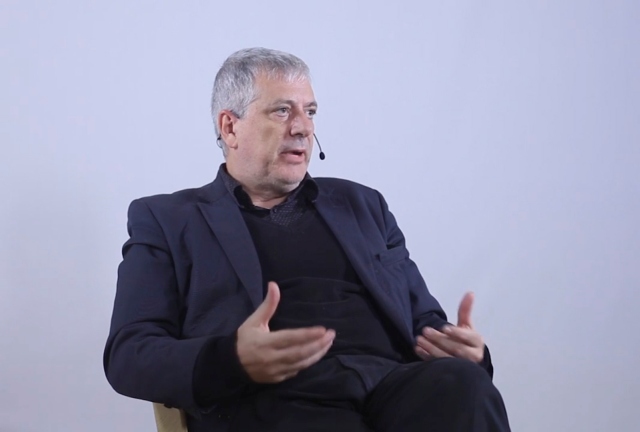Socioeconomic Status and the Brain
Neuroscientist Michael Thomas on children’s environment, the influence of poverty on the brain, and ADHD
videos | May 22, 2017
Cognitive neuroscience is an area that’s expanding in its influence and tackling many phenomena that previously were left psychologists or educators in sociology. One of the examples of a recent area was cognitive neuroscience had offered new insights in the area of socioeconomic status and the way it influences cognitive and brain development. Now, we know that the environment can influence children’s development – physically, emotionally, and cognitively.

Socioeconomic status is a kind of construct that combines multiple aspects, but broadly it’s characterizing a family. It’s characterizing the amount of economic resources that family has, but also aspects of social hierarchy, of prestige, of power. Typically in studies, we might measure it by looking at the level of the parents’ education or we might look at the family income. One of the most striking features of socioeconomic status on children’s development is that by the time children start to go to the school you can already see big gaps in their behaviors and cognitive abilities, their vocabulary size of children according to the socioeconomic status, I’ll call it SES, the SES of the families they come from.
Once children start school at three, four, five years of age, those gaps don’t narrow, they often persist throughout the school years. So the big concern there what are these influences of socioeconomic status, how are they impacting on children and what can we do about that to try and close the gaps caused by the differences in family background.
That is the goal of cognitive neuroscience – to understand mechanisms. If we understand causes that enable us to try and intervene and to figure out the easiest way to ameliorate, to reduce the consequences on children’s development of these differences in family background.
If you look at behavior, what’s interesting about the effects of SES on behavior is that they are uneven across different abilities. In fact, that’s one of the puzzles, for instance, there was one study by Daniel Hagman and Martha Farah suggested that perhaps a third of the variation in children’s vocabulary size, their language development, can be explained by socioeconomic status.
It’s a large amount of variability. If you look at areas of children’s behavioral regulation, whether they can control or inhibit their cognitive functions, so-called executive functions, about six percent of the variation is explained by socioeconomic status. A similar amount is explaining the variation of their working memory ability, what they can keep in mind.
But then you look at something like their visuospatial skills – working in space, remembering spatial configurations, there’s not much influence of socioeconomic status on that aspect. Why is it that socioeconomic status would have that uneven kind of influence across the development of different kinds of skills in children?
Ultimately we expect socioeconomic status to have a biological influence at some level. One of the places we want to start is to investigate what effects socioeconomic status may have on the brain. So let me give you an example of a study which was a large one, looking at a thousand children in the US, I think, and this was a study led by Kimberly Noble. What they did was to scan the brain structure of these thousand children and look in detail at the surface area of the cortex, the thickness of the cortex, and see whether they could detect the impact of the families’ socioeconomic status on children’s brain structure.
Now, this is a very kind of gross measure looking at just the amount of white matter and gray matter in the brain. Effects are quite small, the researchers needed a large sample in order to detect these differences, but ultimately they did show variations, particularly in the cortical surface area, according to socioeconomic status. Interestingly, the differences they found were in temporal regions and in frontal regions of the brain. And that fits with what we see in behavior – that temporal regions of the brain are involved in language processing, the frontal regions of the brain are involved in executive function.
It fits with what we’re seeing in behavior. It’s also possible that those parts of the brain have the longest developmental trajectory, and maybe this long period of development for temporal and frontal regions gives the most opportunity for the environment to influence their development.

That’s just looking at structure, but you can also look at the function of the brain. One of the things we can do is to measure the electrical activity going on in the brain by measuring it at the scalp using electricity. It is in very small voltage and what you can do is to see changes in those voltages as children carry out tasks.
There was a study carried out by Courtney Stevenson and Helen Neville where they played children different sounds, and they were only supposed to pay attention to one of the sounds and ignore the other one. Children from a low socioeconomic status background – their brains were less able to ignore, to screen out the information that they were not supposed to pay attention to. They suggested that there was a problem in selective attention in those children. Both evidence on brain structure and brain function that socioeconomic status is having an effect at a biological level.
We have to think about how that’s going to work. What is the actual pathway between which you have these things that you measure in the environment and these effects on brain structure and brain function? Here scientists run into a problem. The problem is we like to detect correlations and they suggest causal pathways. But what we have with socioeconomic status is a kind of mashing together of a lot of correlated factors in the environment. The family that has fewer resources, that they poorer, the parents may be less educated, the house may be in a poorer neighborhood, may be a less structured household, there may be fewer resources, fewer books, fewer toys, and maybe the parents interact with the children differently, they’re more stressed, they have less quality time with the children, the parents may be less healthy, they’re having to work longer hours for lower wages, it may be that when the mother was pregnant maybe she was more stressed, maybe her nutrition wasn’t as high, maybe she has a baby with a lower birth weight, maybe it’s more likely that she gets depressed afterwards.
You find a lot of these factors correlated with socioeconomic status. Which of those is having an effect on brain development and behavioral development? It’s difficult to answer these questions and neuroscience is using a set of different methods. We talked about brain imaging but also looking at animal and computational models of the development of neural systems to try to understand the pathways by which this can take place.
Typically we pull apart two different influences on families, we think about the level of stress in the family, and these are kind of toxic effects of stress. We also think about the level of resources and opportunities in the family. And then we map those into some possible causal pathways affecting brain development, and those are roughly of three different types.
You can think of prenatal effects on a child’s development. These are effects that will happen when the mother is pregnant, maybe she’s more stressed, has poor nutrition, maybe she’s more likely to smoke or to drink. These are effects on the development of the embryo. The second type of effect would be postnatal parenting: the nature of the relationship between the parents and the child, and the nurturing that’s happening. Another type will be the level of cognitive stimulation, how rich the experiences are for the child. These are three different pathways.

Where children have more behavioral problems and they can’t regulate their emotions, maybe that’s coming more from the early parenting and the early nurturing. And maybe when we see differences in language development that’s differences in stimulation in the environment. And then maybe children’s natural experience in the physical world is enough to allow their spatial skills to develop independently from their socioeconomic status.
In this study of socioeconomic status from a cognitive neuroscience perspective, it is important to distinguish between two different viewpoints. You can think of the effects of deprivation and poverty as a sort of deficit. Maybe that would be right if you’re thinking about the effects of chronic stress or the effects of poor nutrition. But you can also think sometimes in terms of adaptation, of children behaving in the way they do given the environment they’re in.
A child in a more threatening environment, a more stressful one, perhaps need to be more vigilant. They can’t focus their attention, they can’t afford to focus their attention, they need to be monitoring more widely. Maybe that’s an adaptation rather than a deficit, and maybe the way children make decisions and regulate their behavior is because for them they’re in a scarce environment. There’s no point in having long-term planning, they need to take what’s in front of them.
We need to think carefully about what are deficits and what are adaptations. The final thing to say about a cognitive neuroscience approach to the effect of poverty is just because we’re finding effects in the brain doesn’t somehow make them immutable, like they’re inevitable. There’s good evidence that the intervention working with families as well as with children to improve the way parents interact with children, to target more resources to those families can have long-lasting beneficial effects on children’s development.




























